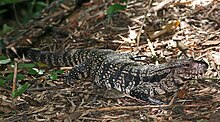Argentine black and white tegu: Difference between revisions
No edit summary |
No edit summary |
||
| Line 11: | Line 11: | ||
| subordo = [[Lacertilia]] |
| subordo = [[Lacertilia]] |
||
| familia = [[Teiidae]] |
| familia = [[Teiidae]] |
||
| genus = ''[[Salvator (genus)]]'' |
| genus = ''[[Salvator (genus)|Salvator]]'' |
||
| species = '''''S. merianae''''' |
| species = '''''S. merianae''''' |
||
| binomial = ''Salvator merianae'' |
| binomial = ''Salvator merianae'' |
||
Revision as of 16:28, 20 March 2015
This article needs additional citations for verification. (January 2015) |
| Argentine black and white tegu | |
|---|---|

| |
| Specimen in Buenos Aires Zoo | |
| Scientific classification | |
| Kingdom: | |
| Phylum: | |
| Class: | |
| Order: | |
| Suborder: | |
| Family: | |
| Genus: | |
| Species: | S. merianae
|
| Binomial name | |
| Salvator merianae | |
| Synonyms | |
|
Salvator merianae Duméril & Bibron, 1839 | |
Salvator merianae, commonly known as the black and white tegu or Argentine black and white tegu,[1] is the largest species of tegu, family Teiidae. It is also known as the Argentine giant tegu.[2] Tegus fill ecological niches similar to those of monitor lizards, and are an example of convergent evolution.
They are an omnivorous terrestrial species that inhabit the tropical rain forests, savannas and semideserts of east and central South America. Just as many other reptiles, Argentine tegus will go into brumation (a form of hibernation) in autumn when the temperature drops. A level of intelligence unusually high for reptiles has been observed, along with a high level of physical activity during the wakeful period of the year. It has been observed and recorded that certain individuals will very regularly, and clearly seek out human affection, just as a dog or cat might. Some intelligent Tegus will form strong connections and attachments towards their keepers. Some have been reported to come on command, and can be house-trained, these are some of the smartest of the large lizards.
Description

As hatchlings they have an emerald green complexion from tip of their snout to midway down their neck with black markings; the emerald green eventually fades to black within a couple of months after shedding. Adult males are much larger than the females and can reach three feet (92 cm) in length at maturity and continue to grow to lengths of 4-4.5 feet (120 to 140 cm). The females are much smaller reaching up to three feet in total length, from nose to tail. They have beaded skin and linear stripes running down their bodies. Adults can reach a weight from 2.5 to 7 kg.[3]
Taxonomy
It was originally known as Tupinambis teguixin, but it was reclassified as subsequent studies showed this species and the gold tegu are distinct from each other. It is sometimes referred to as the Argentine black and white tegu, to distinguish it from the Colombian black and white tegu, another name for the gold tegu; unscrupulous pet dealers will sometimes try to pass off gold tegus as black and white tegus. T. merianae and T. teguixin can be distinguished by skin texture and scale count: T. merianae have two pairs of loreal scales between the eyes and the nostrils, while T. teguixin have only a single pair of loreal scales. T. merianae also have a smoother skin texture. Recent studies classify the Argentine black and white tegu as Salvator merianae.
Diet
Tegus are omnivorous lizards. In the wild, juvenile Argentine tegus have been observed eating a diet consisting primarily of insects, spiders, wild fruits and seeds. As tegus outgrow their juvenile state they begin to move towards a higher protein diet, frequently scavenging eggs from other reptiles, and even eating small birds. However, even adult Argentine tegus continue eating insects and wild fruits as they grow older, as these foods hold essential nutrients to the tegu.
In captivity, tegus are generally fed high protiein diets including things like: raw or cooked chicken, turkey, eggs, insects, small rodents, and fruits. Many captive tegus have an unwillingness to eat fruit. However, there is also some discrepancy as to whether or not the ingestion of unfertilized bird eggs can have an adverse effect on a Tegu’s ability to produce biotin.[4]
In captivity
Argentine tegus make amenable pets, as they have a tendency to become attached to their owners and are generally quite docile as adults. They have a high intelligence level, and can even be house-trained. A healthy animal can live for 15 to 20 years in the wild, and possibly even longer in captivity. However, as with most reptiles, if not handled regularly they will show more aggressive behaviours.

References
- ^ a b Template:IUCN2014.3
- ^ www.wildherps.com
- ^ http://www.uco.es/organiza/servicios/publica/az/php/img/web/17_12_32_15NotaRendimientoBasso.pdf pp2
- ^ Kiefer, Mara C., and Ivan Sazima. "Diet of Juvenile Tegu Lizard Tupinambis meriamae (Teiidae) in Southeastern Brazil." Amphibia-Reptilia 23 (2002): 105-08. Eco Evo. Koninklijke Brill NV. Web. 9 Dec. 2013.

